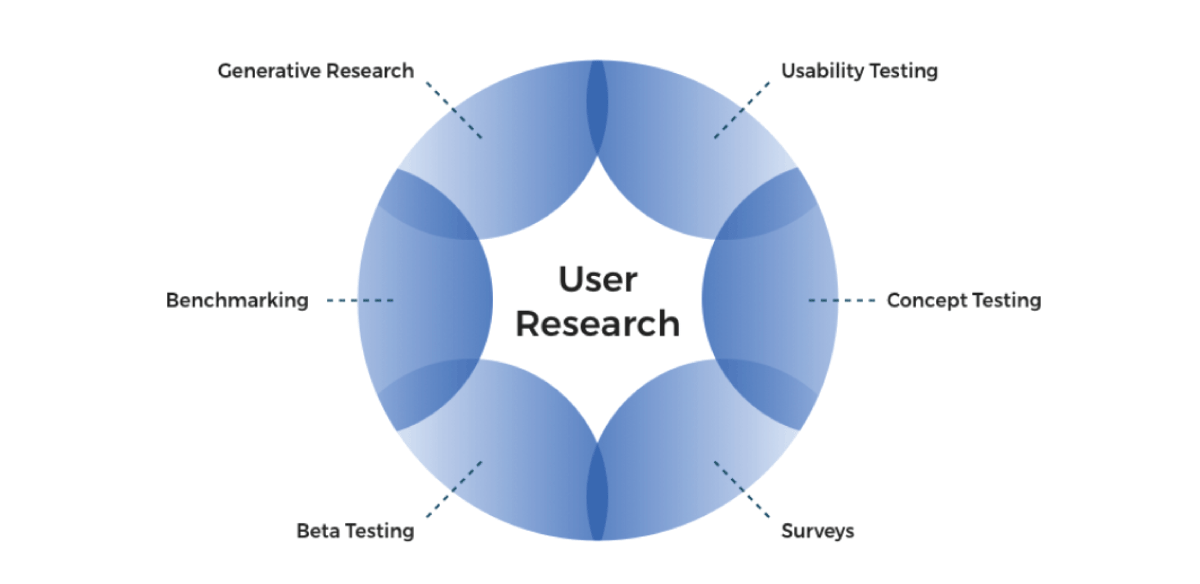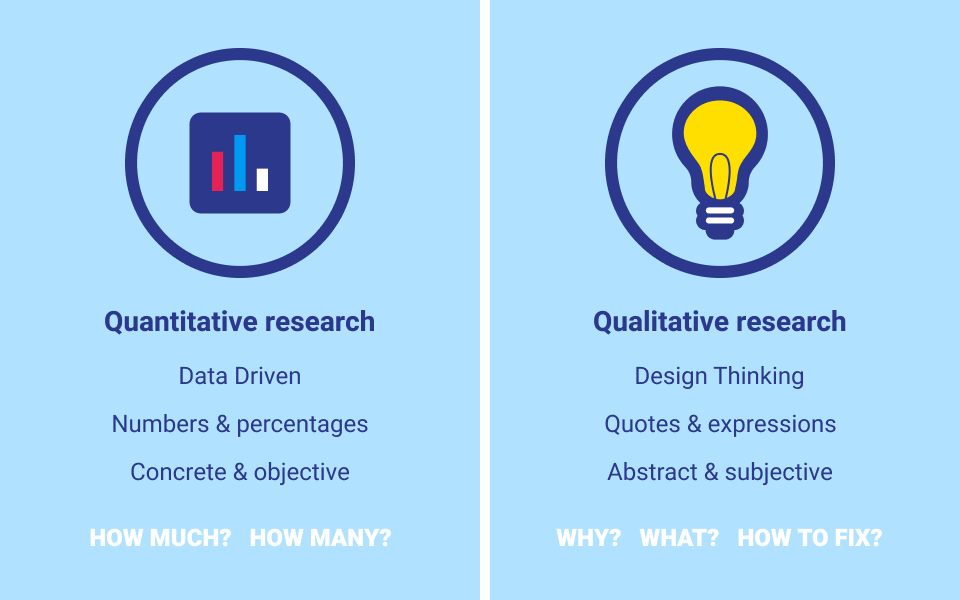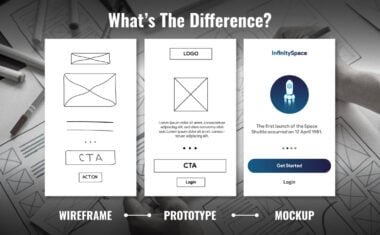Free UX Design Course
Dive into UX design with our free starter course. Transform your creative ideas into user-friendly solutions.
Are you a UX designer that wants to specialize in user research? Do you want to know how to become a UX Researcher? Are you interested in learning different UX research methods? The UX (user experience) industry is all about making products, websites, apps, and services easy and satisfying for customers to interact with. The fundamental goal of UX and user research is to make a product as simple to use as possible so that it’s accessible to customers of all kinds.
To make this a reality, UX teams have to know exactly what customers need, want, and expect from the product. It’s a UX researcher’s job to find the answers and pinpoint the needs of the end users. If you are a UX designer that is passionate about making customers happy, you should consider picking up the UX research skills you need to launch a UX research career.
If you’re interested in becoming a UX researcher and want to learn more about UX research projects, then keep reading—we’ll tell you everything you need to know!
What Is a UX Researcher?
A UX researcher’s primary task is right in the name: UX research, whether it’s quantitative user research or qualitative user research. By using various research and surveying techniques, UX researchers identify problems to be solved, as well as various desires, needs, and expectations that should be met in order to satisfy customer needs and experience. The team of user researchers then use their findings to help guide UX and UI designers in order to create a useful product and UX design.
Most in this field have a background in applied research or behavioral research, many UX researchers come from different backgrounds, either in a UX-related field, or something completely different, like software development. There’s no set educational path that UX designers or researchers have to follow. Many professionals are self-taught and use self-guided resources to pick up the skills they need. Other researchers and design professionals are also good sources of information and there are many online UX communities that can assist with your job search of in providing free resources or advice to help you pick up the necessary skills for a career in UX research. Bear in mind that professional development is often ongoing, with or without an academic degree in a relevant field.


Become A UX Designer. Land a Job or Your Money Back.
Master Adobe XD, Figma, and Sketch. Work 1:1 with an industry mentor. Build a portfolio. Land a job — or your money back.
What Is User Research / UX Research?
UX research, often abbreviated as User Experience research or simply user research, is a systematic investigative process aimed at gaining a deep understanding of users’ behaviors, needs, preferences, and interactions with a product, service, or system. UX research or user research involves employing various methodologies and techniques to gather valuable insights and data that inform the design and development process, ensuring that the end result effectively caters to users’ requirements and enhances their overall experience.
In UX research or user research, experts utilize diverse approaches such as interviews, surveys, usability testing, contextual inquiries, and analytics analysis to comprehensively explore and analyze user perspectives. Through UX research / user research, organizations can identify pain points, uncover opportunities for improvement, and make informed decisions to optimize user satisfaction and engagement. By continually engaging in UX research / user research, companies can refine their offerings, iteratively enhance user interfaces, and create more intuitive and user-centric designs. Ultimately, the core goal of UX research / user research is to create products and services that align seamlessly with user needs and expectations, leading to a positive and fulfilling user experience.
What Does a UX Researcher Do?
Let’s take a closer look at the main tasks of a user experience researcher and what UX research involves.
Conduct User Research To Help Design Better Experiences

To build a good product, it’s imperative to understand the people who are going to use it. UX researchers aim to do this by surveying real potential users and creating “user profiles” whose journeys they can simulate and follow. User research provides valuable insight.
User Recruitment
Finding the right people to contribute to user surveys and data collection is also a part of a UX researcher’s job. In fact, it’s the first step of UX research. The product will have a target audience, but voices outside of this spectrum need to be considered, too. Surveying a selection of people that cover as many bases as possible helps a UX researcher make sure that the data collected is of good quality.
Observe and Collect Data (Usability Testing, Face-to-Face Interviews, User Surveys)
As the development of the product progresses, different kinds of research and data collection can be carried out. Various research methods may apply.
User researchers use surveys and interviews to gauge the wants, needs, and expectations of potential users (research subjects) regarding the product. Later, prototypes can be used to conduct usability testing, allowing designers to see if they are heading in the right direction.
Analyze Data To Find Patterns and Trends

UX researchers generally work with two kinds of research: qualitative and quantitative. Qualitative research deals with aspects that don’t translate well into numbers. This kind of research is used to find out why users feel a certain way and it involves talking to real people and listening to their opinions.
Quantitative research, however, is all about the raw data: what people do, how they do it, and how many people are doing it. By analyzing data of this type, UX researchers can find patterns and trends that can lead to better design principles. For example, knowing how many people could successfully find a certain feature will let the designers know whether the feature needs to be made more visible or not.
Collaborate With Designers, Developers, and Product Managers To Create Solutions That Improve the User Experience
One of the most important aspects of a user experience researcher’s job is making sure the right findings get to the right people. If user researchers kept the results of a survey to themselves, that valuable information could never be put to use.
Get To Know Other Design Students
Erich Schulz
Product Designer at Disney Parks, Experiences And Products
Nicky Arthur
UX Designer at International Baccalaureate
Jenny Kim
Content Creator/influencer at Self-employed
Different UX Research Methods and UX Research Skills You Need To Conduct User Research
UX research methods are used to gather and analyze data about users, their behaviors, motivations, and needs. This information is then used to improve the user experience of products and services.
There are many different UX research methods, but some of the most common include:
- User interviews: User interviews are one-on-one conversations with users to learn about their experiences with a product or service. During user testing, user interviews can be conducted in person, over the phone, or online. The target user can answer research questions, either open-ended or closed, to better understand the audience.
- Surveys: Surveys are a way to collect data from a large number of target users. Surveys can be conducted online, in person, or over the phone.
- Usability tests: Usability tests are a way to test the usability of a product or service by having users complete tasks. Usability tests can be conducted in person or online. These research studies are often conducted as part of a larger product strategy to see how target users will interact with a prototype. The product team may be present for testing to see what the digital experiences of various users are like.
- A/B testing: A/B testing is a research strategy that tests different versions of a product or service to see which one performs better. A/B testing is typically conducted online.
- Analytics: Analytics tools can be used to collect data about how users are interacting with a product or service. This data can be used to identify areas where the user experience can be improved.
In addition to these methods, there are many other UX research methods and research strategies that can be used, depending on the specific needs of the project.
UX researchers need a variety of skills to be successful. Some of the most important skills include:
- Research skills: UX researchers need to be able to conduct research using a variety of methods, including user interviews, surveys, usability testing, and analytics.
- Data analysis skills: UX researchers need to be able to collect and analyze data to identify trends and patterns.
- Communication skills: UX researchers need to be able to communicate their findings to stakeholders in a clear and concise way and require strong communication skills.
- Problem-solving skills: UX researchers need to be able to identify and solve problems with the user experience and need strong analytical skills.
- Empathy: UX researchers need to be able to empathize with users and understand their needs and motivations during their research studies. The job entails working with a number of different users, product managers and product team members during the research process.
UX research is a critical part of the product development process. By understanding users and their needs, UX researchers can help to create products and services that are easy to use and enjoyable for everyone.
Who Should Become a UX Researcher?
In the ever-evolving world of User Experience (UX) design, the role of a UX researcher has gained significant importance. UX researchers play a crucial role in understanding users’ needs, behaviors, and preferences, ultimately shaping the design decisions that lead to exceptional user experiences. If you have a passion for understanding human behavior, conducting research, and influencing design outcomes, a career in UX research might be the perfect fit for you.
UX researchers are responsible for gathering insights through user research to inform the design process. They employ various UX research methods, both qualitative and quantitative, to collect and analyze data that helps uncover user needs, motivations, pain points, and preferences. By conducting in-depth interviews, usability testing, surveys, and observations, UX researchers gain valuable insights that guide the design team in creating user-centered solutions.
They possess a strong understanding of human behavior and the social sciences, psychology, and human-computer interaction. UX researchers have a natural curiosity to dig deeper into users’ motivations and emotions, allowing them to uncover insights that lead to more empathetic and user-friendly designs.
Quantitative research skills are also essential for UX researchers. They utilize statistical analysis and data visualization techniques to make sense of large datasets and uncover meaningful patterns and trends. This data-driven approach complements qualitative research, providing a comprehensive understanding of user behavior and preferences. This skill requires constant professional development.
Effective communication and collaboration skills are vital for UX researchers. They not only need to clearly convey research findings to the design team but also advocate for the importance of UX research within the organization. UX researchers act as the voice of the users, ensuring that their needs and goals are prioritized throughout the design process.
UX researchers are passionate about the entire UX research career. They continuously stay updated on the latest research methods, tools, and industry trends. They have a strong desire to improve user experiences and understand the impact of design decisions on users’ lives. UX researchers thrive in an environment that values user-centered design and embraces the iterative nature of the design process.
While UX research can be a rewarding career, it requires specific skills and a passion for understanding users. If you enjoy conducting research, analyzing data, and translating insights into actionable design recommendations, becoming a UX researcher might be the ideal path for you. Pursuing a degree in human-computer interaction, psychology, or a related field can provide a solid foundation for a career in UX research.
People who are curious, empathetic, and analytical make excellent UX researchers. They possess a combination of qualitative and quantitative research skills, a deep understanding of human behavior, and effective communication abilities. If you have a passion for uncovering user insights and influencing design decisions to create exceptional user experiences, a career in UX research can be a fulfilling and impactful choice.
How To Become a UX Researcher
-
Complete a Course
-
Read and Learn As Much as You Can To Decide if UX Research Is the Right Fit for You
-
Meet the Educational Requirements
-
Develop the Requisite Skills
-
Gain an Understanding of the Essential Tools
-
Get Practical Experience by Working on Projects and Build Your Portfolio
-
Your Network Is Your Net Worth
-
Get a Mentor
-
Tailor Your Resume to the Job You’re Applying To
If you’re interested in becoming a UX researcher, there are a lot of things you can start doing right now that will begin to prepare you for your new career path.
Complete a Course
You don’t need to dive straight into a Bachelor’s degree to enter this field. If you are completely new to the field, start with an Introduction to UX Design. Here you’ll master all of the fundamentals you need to launch your career. If you’re already familiar with the fundamentals, try completing a more intense UX bootcamp to bring your skills up to scratch.
Read and Learn As Much as You Can To Decide if UX Research Is the Right Fit for You
The more information you have, the better—that’s a mantra that UX Researchers live by!
Blogs
Blogs are a great way to gain practical information on the job, like what kinds of skills UX researchers need, and for reading insights and opinions of real-life workers in the industry. There are plenty of blogs run by UX research organizations and the UX research community you can learn from. It’s also a great way to learn about information systems and research methodologies relevant to the field.
Short Courses
Before signing up for college programs or 24-week bootcamps, trying out a few short courses can help you get a taste of the industry, the role, and the kind of studying you’d have to do. It can help you in your job search.
Podcasts (UIE Brain Sparks, UXPod, and Boxes and Arrows)
Get personal anecdotes, professional opinions, and useful insights by listening to podcasts that involve conversations between industry professionals.
Here are some of the podcasts we recommend that you check out:
YouTube Videos
Get to know the ins and outs of the job by following content creators who are currently in the industry This is a great way to get honest opinions on the job of a UX researcher that cover the cons as well as the pros.
Books
Fill up on the wisdom of industry veterans and professors by reading UX research books and textbooks.
Meet the Educational Requirements
Once you’re well-informed and thoroughly convinced that UX research is the field for you, it’s time to really start learning. There are big decisions to make here, and they will cost time and money, so research is key.
Don’t Necessarily Need a Degree, but It Can Be Helpful, Especially in a Related Field
UX Research is a job that revolves around understanding people, and many researchers have backgrounds in subjects like behavioral science, psychology, sociology, anthropology, and humanities. A degree in one of these relevant fields or similar will help get your foot in the door, a bachelor’s degree is not a necessity.
Pursue a Certified Online Course or a Bootcamp
If you don’t have a degree in a related field or don’t have a degree at all, pursuing a UX bootcamp can be a great way to get a relevant education and hands-on experience. With courses that are focused specifically on UX research, you’ll be able to learn a lot of necessary skills in a short amount of time. You’ll also complete a research project for your portfolio.
The purpose of a bootcamp is to get you job-ready, so you will be learning from industry professionals in order to prepare yourself for the job.
Develop the Requisite Skills

While you’re studying with an online UX course or college program, you’ll also need to develop your skills on your own time, as well.
Technical Skills
While user experience researchers are less likely to have front-end coding skills than a UX designer, it’s still good to have some coding skills. If you have or want to develop skills in HTML and CSS, for example, these can be useful when collaborating with UI designers.
- Qualitative Research
There are many different qualitative research methods, such as focus groups, surveys, and interviews. Learning the pros and cons of each and when to use them is an important skill and you’ll need it to complete your first research project.
- Understanding UI Design
Designing the UI of the product will not be your job, but helping guide a UI designer will be. You’ll need a basic understanding of UI design to know how your research findings should affect the design of the user interface. UX designers, product managers and UI designers all work with researchers on a regular basis.
- Creating User Personas
User personas help researchers create a user-centered design. They are fictional personas with personalities and needs taken from data on real people and used in various stages of the design process.
- Producing User Journey Maps
Simulating a user persona’s journey with a product helps keep the design process on track. Are their needs being met? What needs to be changed to improve the experience for them?
- Generating Insights From Data
Some skills with data visualization and analysis (with tools like Microsoft Excel and Tableau) will be necessary to structure and understand larger sets of data that are collected through surveys and interviews.
- Empathy Mapping
Understanding the fine points and nuances of how a user’s experience can make them feel will help UX researchers avoid mistakes that will turn a user away from the product.
- Creating Prototypes and Wireframes
Helping UI designers create prototypes and wireframes will improve your ability to collaborate with them and give them practical examples of how your research can be implemented into the design project.
- Usability Testing
Once prototypes exist, they need to be tested. Potential users, in-house testers, and the UX team themselves can take part in testing to assess how easily and well features can be accessed and used. You’ll work closely with product managers on this aspect of the research.
Soft Skills
The UX research role involves talking to users and encouraging them to share their thoughts and feelings, collaborating with the rest of the UX design team, and convincing them to take your research on board.
This requires excellent soft skills and communications skills, to the extent that UX practitioners and hiring managers believe soft skills to be the most important skill set in UX.
- Problem-Solving
To help push improvements in design, researchers should be able to suggest solutions to the problems they are communicating.
- Analytical Mindset
Analytical skills involve using the information at your disposal to figure out a relevant and objective cause of a problem or solution to that problem.
- Active Listening
Listening to users’ opinions is by far the most important thing for a user experience researcher to do. If you don’t truly listen to the thoughts and feelings your respondents are trying to communicate, your data collection will not be useful and relevant.
- Critical Thinking
Critical thinking allows researchers to spot anomalies in data and fix problems before they grow bigger. It’s an important skill to be able to notice when something doesn’t quite fit and then find out why.
- Organization
Conducting interviews, surveys, analysis, and collaborating with other teams all at the same time all require good organizational skills.
- Teamwork
Teamwork is extremely important for a UX researcher. There is no way to get your research used other than to work with others.
- Communication
Communication is a large part of collaborating with others and conducting research with users. The key is being as clear as possible, and as friendly and respectful as possible.
- Creativity
Creativity will help a researcher come up with new ways to collect data, new ways to view it, and how to best use it in the design thinking process.
Gain an Understanding of the Essential Tools
During your study, you can begin to get a handle on the wide range of tools you would be using on a daily basis as a UX researcher.
Recruitment: Ethnio, User Interview
- Ethnio: A recruitment and management system for user participants.
- User Interview: A dedicated site for recruiting survey and interview participants.
Surveys: Google Forms, SurveyMonkey
- Google Forms: Free survey administration software from Google.
- SurveyMonkey: Free and popular survey software.
Usability Testing: Userlytics, Lookback
- Userlytics: A remote user testing platform.
- Lookback: A usability testing platform.
Analytics: Google Analytics, Hotjar
- Google Analytics: Software to track and report traffic on websites and apps.
- Hotjar: Software for user behavior analytics and heatmaps.
Research and Data Management: Dovetail, AirTable
- Dovetail: Analyze, synthesize, store, and share customer research.
- AirTable: A low-code platform for building collaborative apps.
Get Practical Experience by Working on Projects and Build Your Portfolio
Education and skills are the must-haves for getting into the UX industry, but practical experience and portfolio work will give you a real edge in the job market.
Volunteer Work
Helping out small businesses or projects that otherwise would not have any UX research is a great way to test out your skills and gain some experience.
Sample Projects
Sample projects are a great way to build your portfolio and showcase the skills you have and the kind of research you can do.
Apprenticeship or Internship
Apprenticeships and internships are invaluable experiences that can give new UX researchers a real advantage during job searching. Opportunities can come from unexpected places, so it’s good to check apprenticeship sites regularly.
Freelance
Filling your time as efficiently as possible is a good habit when studying and preparing for a career change. If you don’t have a larger project, apprenticeship, or internship going on, then try out some freelance work until you find something bigger. Your projects will make a good addition to your portfolio.
Your Network Is Your Net Worth
Making friends within the industry is important for your growth and for finding good opportunities.
Check out some of the methods below to get started:
- Online communities such as Discord and Reddit
- UX conferences
- Hackathons
Try your best to connect with other students and industry professionals alike—it might help you down the line.
Get a Mentor
If you meet a professional in the industry that is willing to take you under their wing, take advantage of this unique opportunity. Mentorships do not have to be formal and official partnerships, but finding someone with experience who is willing to answer your questions is very valuable.
Tailor Your Resume to the Job You’re Applying To
To create a compelling UX resume, you should tailor it to the job you’re applying for. Companies want to know that you’re passionate about making their products the best they can be, so doing the research and catering to each specific company will set you above all the generic resumes.
Following a Non-Traditional UX Research Career Path
Do you need to a computer science degree to become a UX researcher or user researcher? If you follow a linear, traditional path – yes. If you are willing to build a UX research portfolio and complete your UX researcher education in a different way – no.
A UX researcher is tasked with completing qualitative research (and sometimes quantitative research). You can land a job (or an internship) with research organizations once you’ve completed a successful research project or research projects.
Doing your own research doesn’t have to be complex, but having a good UX research portfolio is key, especially without a formal UX researcher education. Look into research projects you can complete on your own. Ask friends to answer research question exercises. Work hard to prove your skills as a UX researcher for a year or to before applying. It will pay off!
How Much Can You Make as a UX Researcher?
Here are some average salaries for UX researchers at different stages in their career paths.
Entry-level UX Researcher
In your first year of work, Glassdoor reports the average total salary for an entry-level position to be around $108,009.

Mid-level UX Researcher
After around two years, average salaries rise to around $124,732.

Senior-level UX Researcher
Senior-level UX researchers with 8 or more years of experience can expect to earn an average salary of $152,764. However, Glassdoor reported wages as high as $282,000.

FAQs About Becoming a UX Researcher
Here are some of the most frequently asked questions about becoming a UX researcher.
Are UX Researchers in Demand?
A search on Glassdoor lists 2777 UX researcher job postings in the United States. The UX researcher role is mostly in demand at large companies with big UX teams, whereas small companies may choose to combine the roles of UX designers and researchers.
Is UX Research Hard To Learn?
You will need to be a motivated and determined individual to switch careers and become a UX researcher, but UX research itself is not intrinsically hard to learn. With many courses and resources out there to learn from, it is a very accessible field to get into. You will also need to complete many research projects. You don’t need a bachelor’s degree, you just need experience and motivation.
Related Read: Is UX Design Hard To Learn?
Can You Become a UX Researcher Without a Degree?
Degrees are always useful tools to help get you noticed and get you interviews, but they are not a 100% requirement. Individuals with experience equivalent to a degree, good portfolios with solid research projects, and other certifications can get into a career in user research.
How Can You Become a UX Researcher Without Any Experience?
While you would struggle to get a job as a UX researcher without any qualifications and previous resume entries, you can begin on the path to becoming a UX researcher without prior experience.
You simply need to earn experience as you study and work toward putting yourself on the job market. This can be done with freelance work, portfolio work, apprenticeships, internships, and more.
In User Experience / UX Research, Is There a Difference Between a UX Researcher or a User Researcher?
The terms “user researcher” and “UX researcher” are often used interchangeably, and there can be some overlap in their responsibilities and UX research skills, but they are different.
User researchers typically have a broader focus, conducting research on users and their behaviors in various contexts and in many ways. They may work with UX designers and academic researchers to develop products, provide input in product design, evaluate digital products, tweak final products, and more. User experience UX research is an important part of developing user-friendly products.
User experience researchers, on the other hand, are specifically focused on understanding users’ experiences with products and services, including UX design. The UX researcher may ask questions about product design or a given app to develop products users like, and give feedback to UX design experts and other stakeholders.
How Do You Become a UX Researcher? Do You Need a Four-Year Degree?
You don’t need a four-year degree or bachelor’s degree in Computer Science, Software Development or Information Systems to follow this career path. Potential employers consider your willingness to learn new skills and your years of experience an important factor – more so than a degree. Start building new skills in offline and online UX and product design as a first step. There are many other ways to learn than a full-time college course, so look into fast-paced boot camps and internships where you can gain research experience and get started full-time or part-time if the formal educational path isn’t a good fit for you. Gain work experience in other fields that are closely related before pursuing your research job. Speak to students and other stakeholders and read write-ups online and design your own career path. Remember, your skills and research experience (at different experience levels) may be in high demand, so just get started! Once you better understand the industry, you’ll figure out that there are many ways to learn and get a job that doesn’t involve a degree!
Since you’re here…
Interested in a career in UX design? Rise to the top of the CV pile when you enroll in our UX Bootcamp—you’ll get a UX job or your tuition money back. Take a look at our student reviews and test out our free UX course to get a feel for our style and results. TL;DR: average starting salaries for our students = $85,440. Let’s do this.






